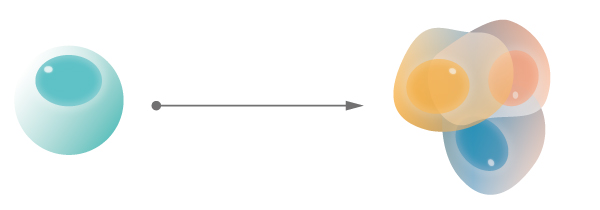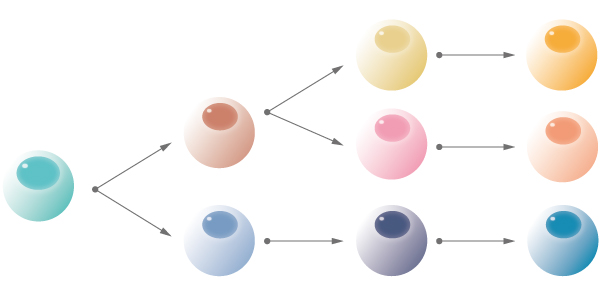
Research Activities
Research Activities
Publications
April 19, 2016
Endoderm-lineage organs have distinct progenitors in definitive endoderm

The inability to distinguish different progenitors cells made it difficult to generate homogeneous endoderm-lineage cells.

Findings by the Osafune lab suggest new markers for different regions of definitive endoderm, which should facilitate the generation of homogeneous endoderm-lineage cells, such as liver and lung.
Although iPS cells can be used to make any type of cell in the body, certain types have proven more difficult than others. In particular, organs such as the lung, liver and pancreas, which all originate from the endoderm, have proven problematic. One reason, according to Professor Kenji Osafune, is our poor understanding of endoderm development. "It is unclear if definitive endoderm cells have the same differentiation propensity," he explains. If not, then differentiation protocols using definitive endoderm cells would be ineffective on a subpopulation, which could explain the difficulty in generating the desired cell type. A new study from his lab shows that indeed, different developmental stages of definitive endoderm produce progenitors for different cell types. This finding not only has important implications on development, but also stem cell-based therapies.
Until now, the different stages of definitive endoderm had only been postulated, but never observed. Osafune's team, however, took advantage of CHIR99021, a small molecule that was previously used to show the same property is true for mesoderm. By simply changing the concentration of this drug in the differentiation protocol, the researchers were able to show that definitive endoderm derived from human iPS cells could be divided into anterior and posterior definitive endoderm, which resulted in different progenitor cells. The anterior definitive endoderm could be broken further into two groups by adding a second small molecule to the protocol. These two groups could then be differentiated into distinct cell populations that respectively resembled lung and liver cells.
Osafune is excited about the basic science impact this finding should have, saying, "This is a good model to study endoderm development." Moreover, the discovery that endoderm can be divided into different populations of progenitors should also be a key step in preparing different endoderm-lineage cells in the lab for patient care.
Paper Details
- Journal: Differentiation
- Title: Redefining definitive endoderm subtypes by robust induction of human induced pluripotent stem cells
- Authors: Kunihiko Matsuo1,2, Shin-Ichi Mae1, Chihiro Okada1, Masahiro Nakamura1, Akira Watanabe1,
Taro Toyoda1, Eiji Uchida2, Kenji Osafune1 - Author Affiliations:
- Center for iPS Cell Research and Application (CiRA), Kyoto University, Kyoto, Japan
- Department of Surgery, Nippon Medical School, Tokyo, Japan






















